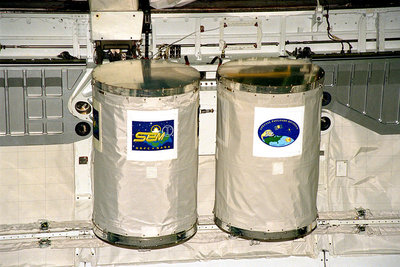Getaway Special
|
|

NASA's Getaway Special program, officially known as the Small, Self-Contained Payloads program, offers interested individuals or groups, opportunities to fly small experiments aboard the space shuttle. To assure that diverse groups have access to space, NASA rotates payload assignments among three major categories of users: educational, foreign and commercial, and U.S. government.
Since the program was first announced in the fall of 1976, payloads have been reserved by foreign governments and individuals; U.S. industrialists, foundations, high schools, colleges and universities; professional societies; service clubs; and many others. Although persons and groups involved in space research have obtained many of the reservations, a large number of spaces have been reserved by persons and organizations outside the space community.
There are no stringent requirements to qualify for space flight. However, each payload must meet specific safety criteria and be screened for its propriety as well as its educational, scientific or technological objectives. These guidelines preclude commemorative items, such as medallions, that are intended for sale as objects that have flown in space.
GAS requests must first be approved at NASA Headquarters in Washington, D.C., by the director of the Transportation Services Office. At that point NASA screens the propriety and objectives of each request. To complete the reservation process for GAS payloads, each request must be accompanied or preceded by the payment of $500 earnest money.
Approved requests are assigned an identification number and referred to the GAS team at the Goddard Space Flight Center in Greenbelt, Maryland., the designated lead center for the project. The GAS team screens the proposals for safety and provides advice and consultation on payload design. It certifies that proposed payloads are safe and will not harm or interfere with the operations of the space shuttle, its crew or other experiments on the flight. The costs of any physical testing required to answer safety questions before launch are borne by the GAS customer.
GAS_mounted_sts-91.jpg
NASA's space shuttle program has specific standards and conditions relating to GAS payloads. Payloads must fit NASA standard containers and weigh no more than 200 pounds (90.7 kg). However, two or more experiments may be included in a single container if they fit in it and do not exceed weight limitations. The payload must be self-powered and not draw on the shuttle orbiter's electricity. In addition, payload designs should consider that the crew's involvement with GAS payloads will be limited to six simple activities (such as turning on and off up to three payload switches) because crew activity schedules do not provide opportunities to either monitor or service GAS payloads in flight.
The cost of this unique service depends on the size and weight of the experiment. Getaway specials of 200 pounds (90.7 kg) and 5 cubic feet (142 L) cost $10,000; 100 pounds (45.4 kg) and 2.5 cubic feet (71 L), $5,000; and 60 pounds (27.2 kg) and 2.5 cubic feet (71 L), $3,000. The weight of the GAS container, experiment mounting plate and its attachment screws, and all hardware regularly supplied by NASA is not charged to the experimenter's weight allowance.
The GAS container provides internal pressure, which can be varied from near vacuum to about one atmosphere. The bottom and sides of the container are always thermally insulated, and the top may be insulated or not, depending on the specific experiment. A lid that can be opened or one with a window may be required. These may also be offered as options at additional cost.
The GAS container is made of aluminum, and the circular end plates are 0.625 inch (16 mm) thick aluminum. The bottom 3 inches (76 mm) of the container are reserved for NASA interface equipment, such as command decoders and pressure regulating systems. The container is a pressure vessel that can be evacuated before or during launch or on orbit and can be repressurized during re-entry or on orbit, as required by the experimenter.
The getaway bridge, which is capable of holding 12 canisters, made its maiden flight on STS-61-C. The aluminum bridge fits across the payload bay of the orbiter and offers a convenient and economic way of flying several GAS canisters.
GAS Experiments
STS-7 - Pugas
Reference
- REDIRECT Template:PD-USGov-NASA
